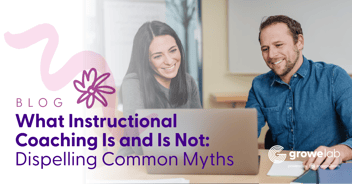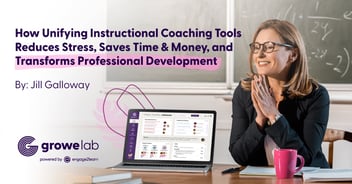Dear Sage On The Stage: Alternatives to Direct Instruction | engage2learn
Picture this: you sign up to attend a professional development program and you’re fired up about the speakers and topics. You’re eager to soak everything in and really get some great takeaways from the experience. But then the speaker comes up and just…lectures.
As adults, we sometimes forget that lecture-style teaching isn’t the best way to make information resonate and ‘stick’ with learners. Click To Tweet
As adults, we sometimes forget that lecture-style teaching isn’t the best way to make information resonate and ‘stick’ with learners. This traditional style of teaching became popular during the Industrial Revolution, when the learning environment consisted of desks in rows. The focus was on delivering information to students, who did not have access to it any other way, and encouraging rote memorization.
Fast forward to today, and we have access to way more information than we could ever want. The demands from our modern workforce dictate that we need learners to enter the world with the ability to collaborate and think critically. Teachers have the opportunity to use all of their creative abilities to create amazing learning experiences for students. Students can easily gain these skills now because teachers don’t have to spend time delivering information that is readily available.
Direct instruction seems like it’s an effective way to pass on information, but in reality, very little of this information sticks with learners. Unless learners are able to apply the information in real-time and learn in a hands-on way, it’s unlikely that they will absorb the information. That means that direct instruction puts a bigger burden on teachers, who want to pass on information, as well as students, who need to learn. What can we do?
Provide Professional Development for Educators
engage2learn has just launched GroweLab, its all-in-one instructional coaching platform that transforms traditional professional development. By incorporating coaching into our professional development approach, we enhance and improve the learning experience, moving beyond the traditional seminar format to a more personalized and impactful 1:1 or group approach. With GroweLab, educators engage in an experiential learning process that allows them to retain and apply what they learn more effectively.
GroweLab is the only instructional coaching platform created by educators for educators. Intentionally designed for public schools based on the following:
- The passion and expertise of a diverse team of elite educators.
- Data from tens of thousands of coaching teachers interactions over 12+ years.
- Extensive, third-party, independent research on adult learning, coaching effectiveness, and best practices. Scalable instructional coaching with powerful, data-informed insights.
- Scalable instructional coaching with powerful, data-informed insights.
Through the coaching process integrated into our professional development, we ensure comprehensive support and growth. GroweLab simplifies tasks, saves valuable time, and optimizes efforts, allowing everyone involved to focus more effectively on coaching, growth, and instruction. Coaches can seamlessly deliver professional development, whether it be online or face-to-face, leveraging the powerful capabilities of the GroweLab platform.
As part of our enhanced teacher professional development plan, we prioritize various topics, including alternatives to direct instruction and strategies for promoting active student engagement. By emphasizing the coaching process within our professional development approach, we offer in-depth support to teachers, enabling them to enhance their instructional practices and foster student success.
Learn more about GroweLab. Get a Demo.
Active Student Engagement
Using the GroweLab platform enhances professional development through coaching, skills and instructional strategies that are coached.
Through GroweLab, educators receive targeted coaching and support in implementing various instructional strategies that promote active student engagement. By honing these skills, teachers can create a dynamic learning environment where students become active participants in their education, leading to improved learning outcomes and a deeper understanding of the subject matter.
Creating a Positive Learning Environment: Coaching empowers educators to explore strategies that create a positive and inclusive learning environment. By fostering collaboration, active listening, and open dialogue among students, teachers can cultivate a classroom environment that supports engagement and participation.
Setting Clear Learning Goals and Objectives: Through coaching, educators can effectively communicate clear learning goals and objectives to students. By adopting a personalized coaching experience, teachers can develop specific and measurable objectives that can be tracked and celebrated as students achieve milestones. Breaking down complex topics into smaller, achievable tasks also helps maintain student engagement throughout the learning process.
Incorporating Active Learning Strategies: Coaching supports teachers in incorporating active learning strategies that promote student engagement. By involving students in hands-on activities and interactive tasks, educators can encourage them to apply their knowledge, think critically, and collaborate with their peers, resulting in an enriched learning experience.
Differentiating Instruction: Coaching empowers teachers to develop strategies that address the diverse learning styles, abilities, and interests of their students. By differentiating instruction, educators can provide a variety of learning materials, resources, and assignments tailored to engage students with different modalities. Coaching also encourages offering choices and self-directed learning opportunities, allowing students to explore topics aligned with their interests and passions.
Leveraging technology to enhance student engagement: Coaching helps educators leverage technology to create engaging learning experiences. By incorporating interactive educational tools, multimedia resources, and online platforms, teachers can enhance student engagement in their teaching. Additionally, coaching supports the integration of gamification elements, making learning enjoyable and challenging. Educational apps and platforms that provide immediate feedback, personalization, and opportunities for collaborative learning can also be explored.
Incorporating Real-World Connections: Coaching supports educators in relating the content to real-world applications and examples that are meaningful to students. By helping teachers make connections between the curriculum and real-life experiences, coaching enhances student engagement and motivation to learn.
Assessing Progress and Providing Timely Feedback: Coaching enables educators to regularly assess student progress using diverse methods and provide timely feedback. By implementing ongoing, formative, and varied assessments, teachers can capture different aspects of student learning. Recognizing and celebrating achievements, as well as acknowledging student effort, fosters motivation and continued engagement.
By integrating coaching into professional development, we enhance active student engagement and empower educators to create impactful learning experiences. Through personalized coaching experiences, teachers can unlock their full potential and positively impact student success.
Alternatives to Direct Instruction
There are many alternatives to lecture-style teaching. The key is to ensure learners are actively engaged in the process of learning. Listening to a lecture isn’t the best way for students to synthesize information that ‘sticks.’
Try these alternatives to direct instruction to motivate students to take the reins of their own learning.
Learning groups
Learning groups are a great alternative. Place students in clusters of desks where they have the opportunity to collaborate with one another. Let the students conduct research on a particular topic. They can create roles and norms to govern how the group operates.
Learning groups enable students to both teach themselves and teach others in their group. Click To TweetLearning groups enable students to both teach themselves and teach others in their group. The educator acts as a facilitator, answering questions and guiding learners through the research process. The educator can then also pull small groups for more effective direct instruction in smaller groups.
Simulations
Many students learn through example. Simulations are a fantastic way to encourage learning through real-world applications.
For example, if you’re teaching professional ethics, you can stage skits put on by the students about different ethical situations. Freeze the skits and quiz the class on what they should do in the situation. Simulations also work well in history classes to re-enact famous speeches, English classes to breathe life into Shakespeare, and even math classes to demonstrate how math principles translate into the real world.
Simulations shake things up in the classroom and allow students to explore their creativity while learning. Bringing the lessons to life deepens the understanding and retention of information.
Problem-solving in the community
Learners need to be Future Ready, and that means they should emerge from our public schools as educated citizens.
In our fast-paced digital world, it’s important to instill a sense of empathy in our students. Direct instruction makes it difficult for students to concern themselves with real-world issues. A great way to encourage learners to develop empathy while they learn is through community problem-solving.
Let’s say you’re an English teacher and your 7th grade class is reading the book Holes. Once students read the book, they can take on a group project addressing the issue of prison reform. Students conduct research through a structured process and present their findings to the class at the end of the project.
Tackling a community problem gets learners more engaged when they realize they can take on real-world issues. Click To TweetTackling a community problem gets learners more engaged when they realize they can take on real-world issues. It’s an excellent way to provide relevant learning experiences.
Looking for more resources? Here are 50 other alternatives to direct instruction. Ultimately, by embracing innovative instructional strategies, educators empower their students to become lifelong learners equipped with the skills and knowledge necessary for success.
Active learning can take many forms. The key is that learners are in charge of their learning while feeling motivated. That’s much more powerful and effective than listening to the sage on the stage.



